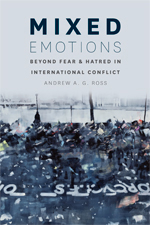By Andrea Gibson
When America was attacked by terrorists on 9/11, various commentators compared the incidents to Pearl Harbor, which was the last time foreign enemies had invaded U.S. soil. Although the two attacks were different in nature and context, those analogies helped stir up emotions Americans had about World War II that influenced their views of and responses to 9/11, says scholar Dr. Andrew Ross.
Ross, Assistant Professor of Political Science, is the author of Mixed Emotions: Beyond Fear and Hatred in International Conflict (University of Chicago Press). Although his field of political science often views human behavior through a rational lens, Ross explores the complex ways emotion impacts the political process in areas such as public responses to terrorism, ethnic conflict and nationalism, and international justice.
“Emotional behavior is often used as a way to undermine the credibility of certain actors. If there are people who are seen as acting on their emotions, they’re assumed to be irresponsible or maniacal or unreliable participants in the political process,” says Ross.
 But scholars should take emotions seriously, he argues, as they can help us understand why people care so intently about matters at stake in political life.
But scholars should take emotions seriously, he argues, as they can help us understand why people care so intently about matters at stake in political life.
The author cites several examples in the book, including the 9/11 and Pearl Harbor case, about how emotions also can have a “contagious quality,” bleeding from one event to the other.
“For example, after 9/11, there was a fear of terrorism, air travel, and other things connected to it,” he says. “But those also carried over to this pandemic of fear associated with anthrax. The two weren’t connected at all, and yet in the media coverage and the public discourse about terrorism in 2001, they were inseparable. They were part of this poorly understood and ambiguous fear or sense of fear.”
The ability for emotions to seep through events also can help us understand the ethnic nationalism that erupted in Yugoslavia during the 1980s and 1990s, Ross notes. Although the movement, which led to civil war and the creation of new nation states, is often attributed to the uprising of citizens after years of repressive communism, Ross argues that the situation was more complicated than that.
“There was a very serious economic crisis that led to anxiety and anger among those who were unemployed and people who were otherwise adversely affected. The grievances tended to carry over to national politics. There was enough ambiguity about the emotions they had that (the two grievances) seemed compatible,” he explains.
Ross also argues that it’s worth taking a look at how emotion is transmitted in political speeches and statements by officials. While political scientists may analyze the meaning of public addresses and symbols, there are a variety of paralinguistic elements—tone of voice, hand gestures, facial expressions—that are important as well, he says.
That’s something well understood in disciplines such as sociolinguistics or neuroscience—among the fields Ross drew on for the scholarly work of the new book—but hasn’t been analyzed much in political science, he says. Acknowledging these paralinguistic factors, Ross adds, requires adjusting the way tribunals and other judicial bodies establish responsibility for inciting genocide and other war crimes.
Ross also is interested in how communication technologies such as streaming video and social networking allow emotionally resonant messages to be transmitted on a wider scale. In the next phase of his research, Ross plans to further develop his analysis of how these digital tools can communicate human suffering across geographic and political boundaries.
This article appears in the Spring/Summer 2014 issue of Ohio University’s Perspectives magazine.




















Comments